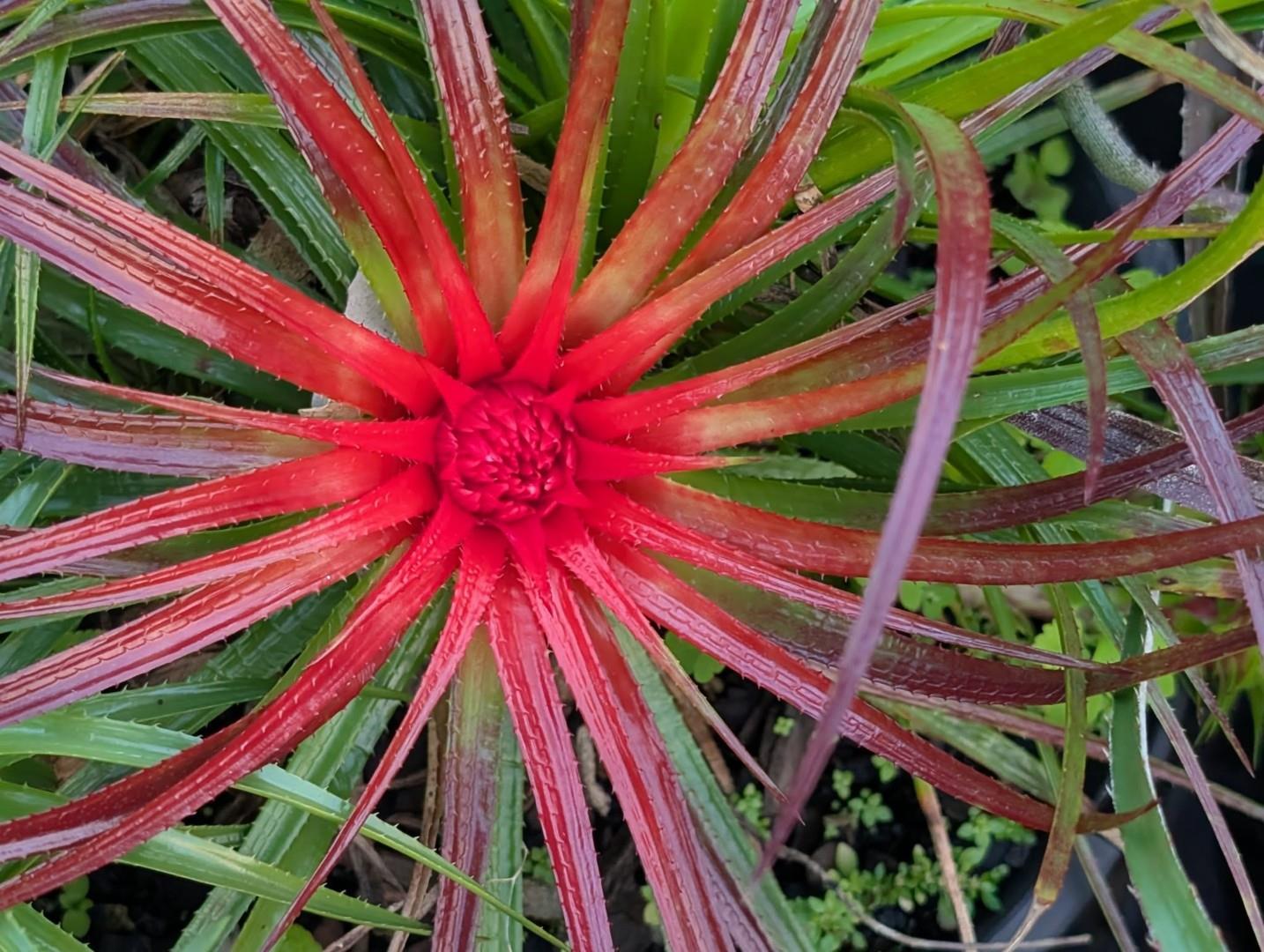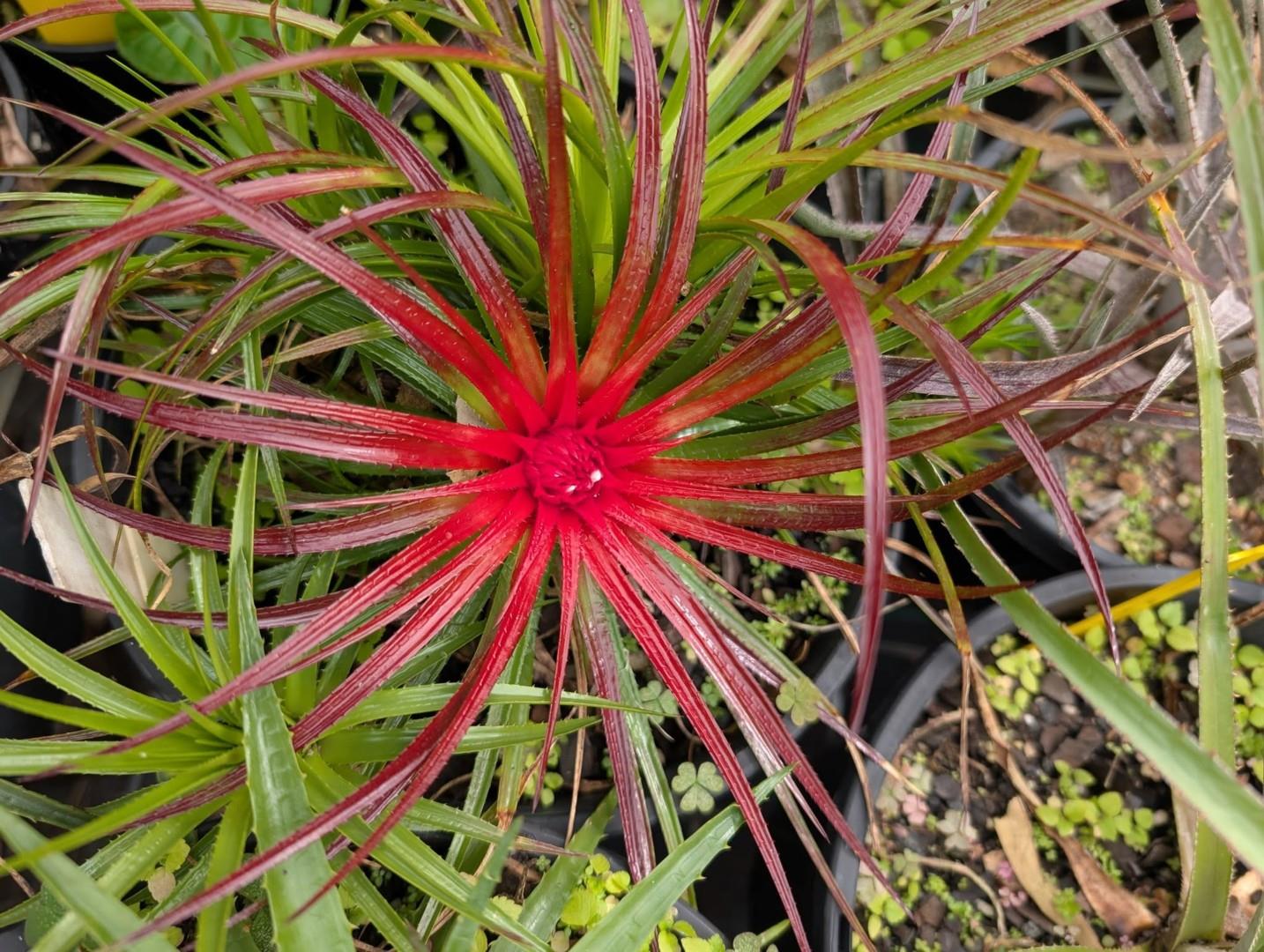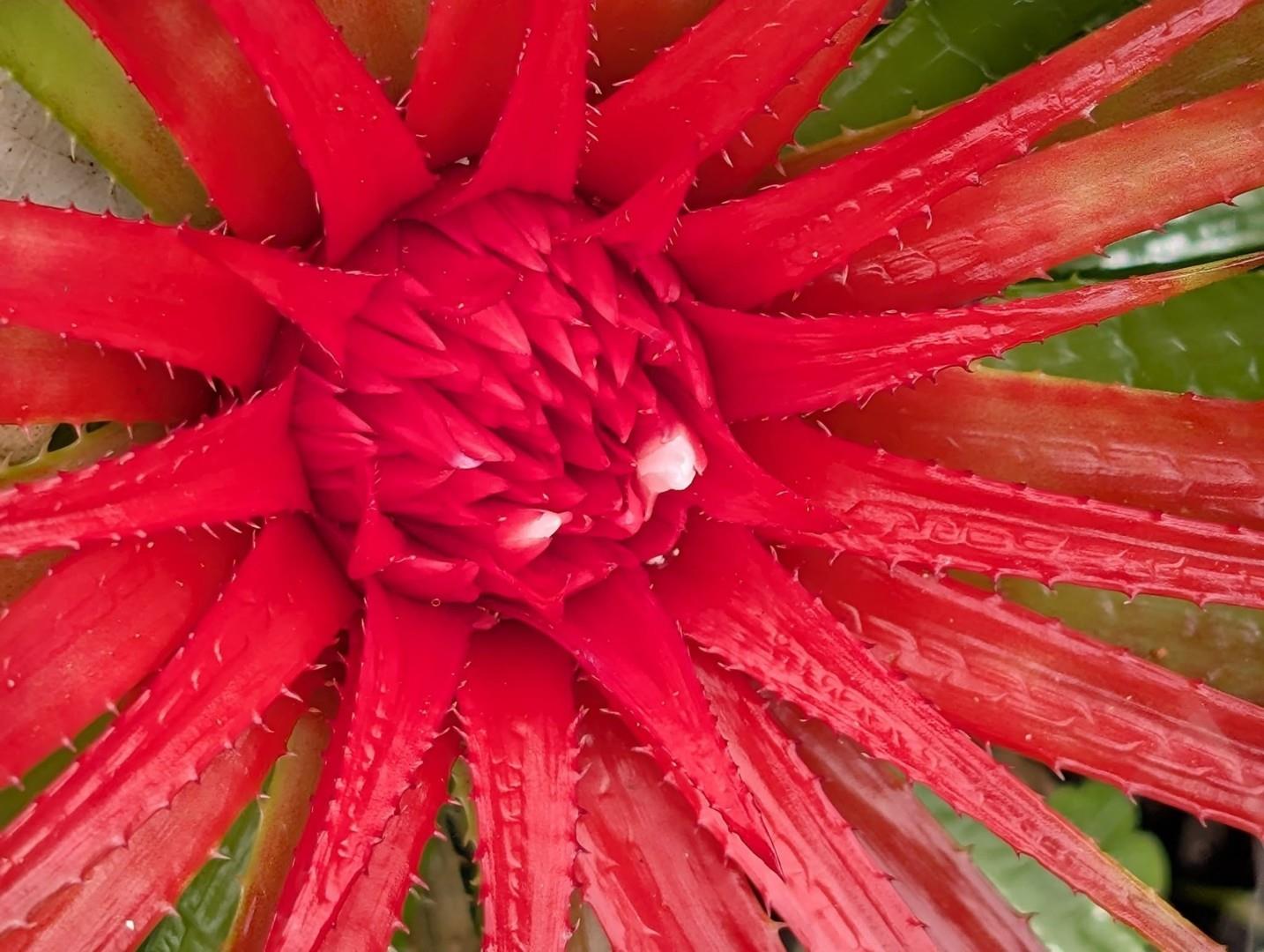


Uma nova especie de Orthophytum Beer (Bromeliaceae) relacionada a Orthophytum navioides (L B. Sm.) L B. Sm.
Rafael Batista Louzada e Maria das Gracas Lapa Wanderley
Racebido: 14:02.2008; aceito: 04.09.2008
ABSTRACT- (A new species of Orthophytum Beer (Bromeliaceae) morphologically related to Orthophytum navioides (L.B. Sm.) L.B. Sm.). The present work aimed and describing and illustrating a new species Orthophytum ophiuroides restricted from Lencois in Bahia state, Brazil, besides elucidate the circumscription of Orthophytum navioides (L.B. Sm.) L.B. Sm. Orthophytum ophiuroides is closely related to O. navioides (L.B. Sm.) L. B. Sm., however, O. ophiuroides has floral bracts and sepals red (vs. green), small petals (ca. 1,5 x 0,4 vs. 2,5 x 0,7 cm), capitate trichomes in sepals and petals absent (vs. capitate trichomes in sepals and petals).
Introducao
O genero Orthophytum e representado em geral, por plantas rupicolas, habitando substratos secos sobre afloramentos rochosos, espostas a alta luminosidade ou ainda em paredoes umidos sombreados a beira de rios encachoeirados (Versieux & Leme 2007, Wanderley 1990, Wanderley & Conceicao 2006).
Orthophytum foi descrito por Beer (1854), no entanto nao foi aplicado um epiteto especifico ao material analisado. Segundo Smith & Downs (1979), o genero e representado por 17 especies. Entretanta, considerando as especies posteriormente publicadas a genero reune atualmente 55 especies e sete variedades (Luther 2006, Versieux & Leme 2007).
O genero Orthophytum distribui-se desde a regiao Nordeste ate o Sudeste do Brasil, ocorrendo nos estados de Pernambuco, Paraiba, Bahia, Minas Gerais e Espirito Santo, apresentando dois centros de diversidade, a Cadeia do Espinhaco, entre os Estados da Bahia e Minas Gerais e os inselbergs no dominio da Mata Atlantica nos Estados do Espirito Santo e Minas Gerais. (Leme 2004, Wanderley & Conceicao 2006).
Como parte da revisao taxonomica do genero Orthophytum, verificou-se que a identidade de Orthophytum navioides nao era muito clara, especialmente pelo material-tipo dessa especie ser incompleta, com ausencia de petalas e sem informacoes importantes na etiqueta de herbario. Sendo assim, as escassas colecoes de O. navioides sao, algumas vezes, confundidas com O. amoenum, uma especie tambe endemica da Chapada Diamantina e com delimitacao imprecisa.
O presente trabalho apresenta a descricao de uma nova especie, Orthophytum ophiuroides Louzada & Wand., procedente do Municipio de Lencois no estado da Bahia, alem de esclarecer a circunscricao de O. navioides (L B. Sm.) L.B. Sm., morfologicamente relacionada a nova especie e que apresentava identidade pouco conhecida ate o momento.
Material e metodos
Para a realizacao deste estudo, foram examinadas colecoes de diversos herbarios (acronimos segunda Holmgren et al.1990), alem das novas coletas obtidas nas tres expedicoes botanicas realizadas na Chapada Diamantina. As colecoes foram incorporadas ao acervo do Herbario SP e alguns representantes vivos foram incorporados na colecao do bromeliario do Instituto de Botanica, Sao Paulo.
Para o estudo complementar das descricoes dos taxons, materiais em flor e/ou fruta foram fixados em etanol 70%, provenientes das coletas realizadas durante o desenvolvimento do presente trabalho.
A terminologia empregada segue Radford et al. (1974).
Resultados e Discussao
Orthophytum ophiuroides Louzada & Wanderley sp. nov. Hoehnea 35(3): 405-10, 3 fig., 2008
Tipo: BRASIL. BAHIA: Lencois, Rio Mandassaia, 15-I- 2006, M.G.L Wanderdey et al. 2532 (holotipo: SP, isotipo: HUEFS).
Figuras 1, 3A-C
Species nova (Orthophytum navioides (L.B. Sm.) LB. Sm. affine, sed bracieis florigeris et sepalis rubris (vs. viridibus), petalis minoribus (ca. 1,5 x 0,4 vs. 2,5 x 0,7 cm), tichomatibus capitatis sepalorum et petalorum nullis differt.
Ervas rupicolas de pequeno porte, estoloniferas, caule curto, 1,2-3 x 1,5-2 cm. Folhas numerosas, densamente imbricadas, eretas a suberetas nas plantas jovens, l0-27 cm compr.; bainha esbranquicada, com a base alargada, oval, 4-8 x 7-8 mm, glabra, margens espinescentes, espinhos 0,5 mm compr.; lamina subcoriacea, verde, vermelha na base, lucida, linear-triangular, 0,6-26 x 0,2-0,4 cm, esparsamente lepidota em ambas as faces, face abaxial nervada, margens espinescentes, espinhos antrorsos, 0,3-0,4 mm, apice longamente atenuado. Inflorescencia sessil, multiflora, ca. 15-20 flores, composta, ramos externos portando 2-3 flores; bracteas primarias foliaceas, vermelhas, oval-filiformes a oval-lanceoladas, 2-8,5 cm, lepidotas, margens espinescentes, apice agudo; profilo presente. Bracteas florais subcoriaceas, vermelhas, assimetricas, as mais internas carenadas, triangulares, 0,9-1,2 x 0,6-0,7 cm, margens denticuladas, inteiras nas mais internas, apice mucronulado. Sepalas vermelhas, assimetricas, fortemente carenadas, triangular-lanceoladas, ca, l x 0,3 cm, glabras, margens inteiras, apice acuminado-atenuado. Petalas alvas, linear-¬espatuladas, ca. 1,5 x 0,4 cm, apice obtuso, apiculado, apendices petalineos saciformes, lacerados, a ca. 6 mm da base das petalas, calosidades evidentes. Tubo egigino inconspicuo. Estames do primeiro verticilo adnatos as petalas na porcao basal, porcao livre do filete ca. 3,5 mm compr., o segundo verticilo com filetes livres, opostos as sepalas, ca. 9 mm compr., anteras ca. 2,3-2,5 mm compr., apice apiculado. Ovario trigono, estilete com a base inflada, ca. l cm compr., estigma simples ereto. Frutos e sementes nao vistas.
Paratipos: BRASII,. BAHIA: Lencois, Poco Halley, l3-I-2006, R B. Louzada & C A.C.Moreira 7 (SP); margem do Rio Mandiassaia,l5-I-2006, M G.L. Wanderley et al. 2531 (SF); margem do Rio Lencois, 8-IV-2008, RB. Louzada & M.G.G. Wanderley 88 (SP).
Orthophytum ophiuroides (figura 3A) assim como outras especies do genero, tais como, O. humile L.B. Sm. e O. navioides (L.B. Sm.) L.B. Sm., habitam rochas sombreadas nas margens de rios encachoeirados.
Leme (2004) considera o genero Orthophytum dividido em complexos e subdivide os mesmo em subcomplexos de especies. Nesta concepcao, O. ophiuroides esta incluido no subcomplexo "amoenum", caracterizado pela presenca de petalas alvas, com o centro da roseta vermelho intenso, passando a verde, contrastando com as outras folhas. O caule e curto e inconspicuo como na maioria das especies do genero.
Wanderley & Conceicao (2006) reportaram as materiais Wanderley et al. 2531, 2532 e Louzada & Moreira 7 como O. navioides, especie cujo material-tipo e bastante escasso, sendo, em decorrencia disso, pouco conhecida, dificultando sua identificacao. Apesar das semelhancas quanto ao habito destas duas especies, Orthophytum navioides e O. ophiuroides distinguem-se pela morfologia floral e pela distribuicao geografica das mesmas. Orthophytum navioides apresenta bracteas e sepalas verdes (figura 3D) e com tricomas capitados, enquanto O. ophiuroides as bracteas e sepalas sao vermelhas (figura 3A-C) e nao apresentam tricomas capitados.
O habito bastante delicado de Orthophytum ophiuroides pode ser tambem confundido ao primeiro exame com O. humile, entretanto estas duas especies sao bem distintas, com a presenca de laminas foliares mais largas e glabras em O. ophiuroides vs. laminas foliares estreitas e densamente lepidotas em O. humile.
O nome escolhido para esta especie decorreu em funcao da semelhanca do habito da planta com a forma dos, animais marinhos da classe Equinodermata.
Introduction
The genus Orthophytum is represented in general, by rupicolous plants, inhabiting dry substrata on rocky outcrops, exposed to high light or on shaded humid faces of waterfalls near the edge of rivers (Versieux & Leme 2007, Wanderley 1990, Wanderley & Conceição 2006).
Orthophytum was described by Beer (1854), however the epithet was not applied specifically to analyzed material. Secondly, Smith & Downs (1979), showed the genus with 17 species. Meanwhile, the species later published to the genus now reaches 55 species and seven varieties (Luther 2006, Versieux & Leme 2007).
The genus Orthophytum is distributed from the Northeast to the Southeast areas of Brazil, occurring in the states of Pernambuco, Paraíba, Bahia, Minas Gerais and Espírito Santo, with two diverse centres, the Cadeia do Espinhaco, between States of Bahia and Minas Gerais and the inselbergs in the domain of the Atlantic forest in Espírito Santo and Minas Gerais states. (Leme 2004, Wanderley & Conceição 2006).
As part of the taxonomic revision of the genus Orthophytum, the identity of Orthophytum navioides was verified as being not very clear, especially in the type material for that species which was incomplete, with absence of petals and without important information on the herbarium label. Because of this, the scarce collections of O. navioides are, sometimes, confused with O. amoenum, a species also endemic to the Chapada Diamantina and with imprecise delimitation.
The present work shows the description of a new species, Orthophytum ophiuroides Louzada & Wand., coming from the Municipality of Lencois in the state of Bahia, while explaining the habitat of O. navioides (L B. Sm.) L.B. Sm., related morphology to the new species and presents little known information at the moment.
Material and methods
For the accomplishment of this study, collections of several herbaria were examined (acronyms seconded by Holmgren et al.1990), and all of the new collections obtained in the three botanical expeditions made in Chapada Diamantina. The collections were incorporated in the collection at Herbárium SP and some live representatives were incorporated in the bromeliad collection of the Institute of Botany, São Paulo.
For the complemental study of the descriptions of the taxa, materials in flower and/or fruit were fixed in ethanol 70%, coming from collections made during the development of the present work.
The terminology used follows Radford et al. (1974).
Results and Discussion
Orthophytum ophiuroides Louzada & Wanderley sp. nov. Hoehnea 35(3): 405-10, 3 fig., 2008
Type: BRAZIL. BAHIA: Lencois, Rio Mandassaia, 15-I - 2006, M.G.L Wanderdey et al. 2532 (Holotype: SP, Isotype: HUEFS).
Illustrations 1, 3A-C
Species nova Orthophytum navioides (L.B. Sm.) L B. Sm. affine, sed bracieis florigeris et sepalis rubris (vs. viridibus), petalis minoribus (ca. 1.5 x 0.4 vs. 2.5 x 0.7 cm), trichomatibus capitatis sepalorum et petalorum nullis differt.
Herb rupicolous of small size, stoloniferous, short stem, 1.2-3 x 1.5-2 cm.
Leaves numerous, densely imbricate, erect to suberect in young plants, l0-27 cm long;
Sheaths whitish, with an enlarged base, oval, 4-8 x 7-8 mm, glabrous, margins spinescent, spines 0.5 mm long;
Blades subcoriaceous, green, red at the base, lucid, linear - triangular, 0.6-26 x 0.2-0.4 cm, sparsely lepidote on both faces, abaxial face nerved, margins spinescent, spines antrorse, 0.3-0.4 mm, not as long towards the apex.
Inflorescence sessile, multiflowered, ca. 15-20 flowers, compound, external branches with 2-3 flowers;
Primary bracts leaflike, red, oval-filiform to oval-lanceolate, 2-8.5 cm, lepidote, margins spinescent, acute apex; profile present.
Floral bracts subcoriaceous, red, asymmetrical, the more internal carinate, triangular, 0.9-1,2 x 0.6-0.7 cm, margins denticulate, entire in the more internal, apex mucronulate.
Sepals red, asymmetrical, strongly carinate, triangular-lanceolate, ca, l x 0.3 cm, glabrous, margins entire, apex acuminate-attenuate.
Petals white, linear - spatulate, ca. 1.5 x 0.4 cm, obtuse apex, apiculate, petal appendages sacciform, lacerated, to ca. 6 mm from the base of the petals, evident callosities.
Epigynous tube inconspicuous.
Stamens of the first whorl adnate to the petals in the basal portion, free portion of the filament ca. 3.5 mm long, the second whorl with free filaments, opposite to the sepals, ca. 9 mm long, anthers ca. 2.3-2.5 mm long, apex apiculate.
Ovary trigonous, style with an inflated base, ca. l cm long, stigma erect simple.
Fruit and seed not seen.
PARATYPES: BRASIL. BAHIA: Lencois, Poço Halley, l3-I -2006, R B. Louzada & C A.C.Moreira 7 (SP); margin of Rio Mandiassaia, l5-I-2006, M G.L. Wanderley et al. 2531 (SF); margin of Rio Lençóis, 8-IV-2008, RB. Louzada & M.G.G. Wanderley 88 (SP).
Orthophytum ophiuroides (Fig 3A) as well as other species of the genus, such as O. humile L.B. Sm. and O. navioides (L.B. Sm.) L.B. Sm., inhabit shaded rocks in the margins of river waterfalls.
Leme (2004) considers the genus Orthophytum as divided in complexes and subdivided into subcomplexes of species. In this conception, O. ophiuroides is included in the subcomplex "amoenum", characterized by the presence of white petals, with the centre of the rosette intense red, passing to green, contrasting with the other leaves. The stem is short and inconspicuous as in most of the species of the genus.
Wanderley & Conceição (2006) considered the materials Wanderley et al. 2531, 2532 and Louzada & Moreira 7 as the species O. navioides whose type material is quite scarce, and was the reason for this identification. In spite of the similarities in the habit of these two species, Orthophytum navioides and O. ophiuroides can be distinguished by the floral morphology and the geographical distribution.
Orthophytum navioides has green bracts and sepals (Fig 3D) and with capitate trichomes, while O. ophiuroides the bracts and sepals are red (Fig 3A-C) and they don't have capitate trichomes.
The quite delicate habit of Orthophytum ophiuroides can be confused also, on first examination, with O. humile, however these two species are very different, with the presence of wider glabrous leaf blades O. ophiuroides vs. narrow and densely lepidote leaf blades in O. humile.
The chosen name for this species was based on the similarity of the habit of the plant with the form of the sea animals of the class Equinodermata.